
Holly Woodman
This research investigates how contemporary artists depict physical chronic health conditions throughout their practice. This topic raises issues that have been relevant throughout history, but even more so in present times, such as illness, isolation, therapy, and the correlation between physical and mental health. My research is centred on the use of practice-based research with myself as someone who has personal experiences with chronic physical illnesses. The writings of R Crone, Vanessa Corby, and Barbara Rodriguez Munoz will help to analyse the works of Eva
Hesse and Louise Bourgeois, as they pursue the exploration of artistic concepts surrounding illness, isolation, and displacement. Critical links will be made to primary resources including personal medical files and experiences. The works of Frida Kahlo, Hannah Wilke, and Tracey Emin will be explored to investigate the
relationship and connections between physical and emotional health and the ways they can intertwine and overlap. By analysing the work of these three artists, I hope to gain insight into how art can enhance our understanding of chronic health conditions in a more contemporary context.
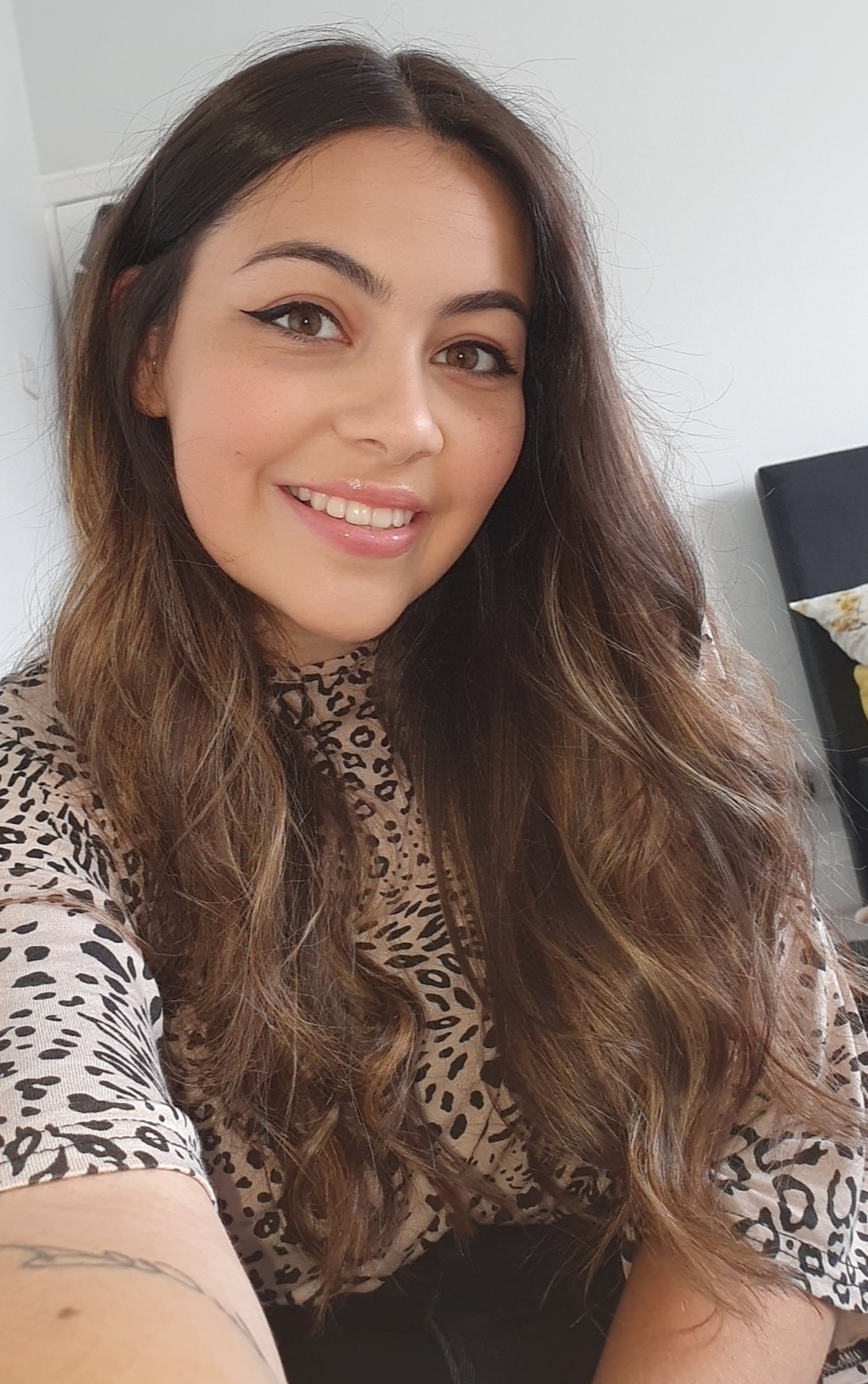
Holly Woodman
WARNING: THIS POSTER CONTAINS IMAGES THAT MAY CAUSE DISTRESS.
The research I am conducting explores the ways contemporary artists depict their personal physical health conditions throughout their artistic practice. Artists such as Frida Kahlo, Hannah Wilke, and Tracey Emin will be discussed due to the relevance that these female artists have all battled with chronic illness during their life and have documented their illness throughout their practice. This subject matter is of personal relevance as my practice also documents all attributes of my chronic illness, both physical and mental.
The reason this research has significance today is historically the disabled art movement developed in the 1970’s/80’s following the success of the Disabled Peoples’ Movement. Classically, most artworks depicting the themes of disability were created by artists without disability. By reflecting on their own experiences, disabled artists were able to provide a real and honest perspective on chronic illness.
Although disability art in the 21st century is not as highly political as it once was, there is still need for awareness. As disabled and chronically ill artists and practitioners are being included in the mainstream art industry, this enables a wider and more diverse audience to feel represented in art galleries, it encourages them to view, and experience the artworks.
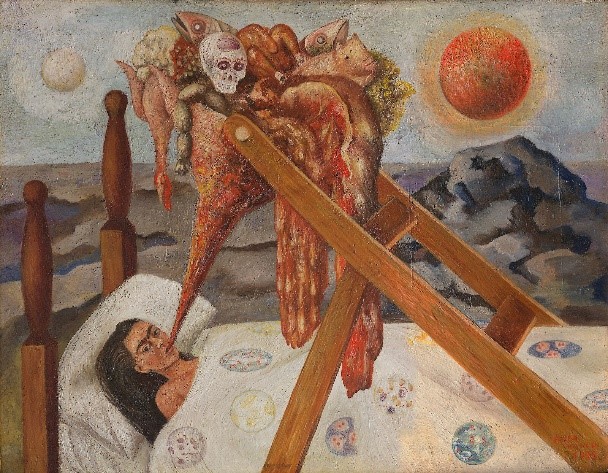
Kahlo, F. (1945) Without Hope [Oil on Canvas]. Museo Dolores Olmedo, Mexico.
“Pain is inherently lonely because it cannot be shared, and it can cause us to disengage from others and even from ourselves. Art is one way to work through pain, while at the same time connecting with oneself.” (Stahl, 2016, p.2). Frida Kahlo is an artist who famously used her art to communicate her experience of pain caused by her disabilities. Without Hope offers the viewers an insight to the many illnesses Kahlo suffered with throughout her life. She experienced a reduced appetite and a loss of weight due to her illnesses and large quantity of surgeries. This painting documents one of Kahlo’s treatments of being force-fed a blend of fattening foods to tackle her weight issue. It allows the viewer to experience the emotions that coincide with chronic pain and illness, there is a sense of overwhelming upset and pain as you can see the artist crying whilst being restricted by an easel and a large funnel of several meats and animals.
Hannah Wilkes’ Intra-Venus exhibition showcases a startlingly honest documentation of the artists last couple of year of her life. The exhibition contains a range of artworks, including large scale images that allows the viewer to experience the progressive stages that patients endure of chemotherapy. Wilke does not hide anything from her audience as she depicts everything for example, damage on her tongue caused by radiation, hair loss from chemotherapy, and her bruised body from bone marrow harvest.
In Bandages from Bone Marrow Harvest, we can see Wilke standing with bandages taped to her hips where her bone marrow has been harvested as treatment for Lymphoma. ‘The viewer gets a sense of the rapidity of the disease, it’s ability to tear swiftly through the body.’ (Cheney, 1994), which can be seen in Intra-Venus Series No. 1 as Wilkes’ body in the image on the right is presented with strength and shapeliness, this strength is then cruelly stripped away in the image on the right where we see a more swollen and limp Wilke with an exhausted expression on her face making an uneasy and painful transition for the viewer.
As an unfamiliar audience it is more common to recoil from subjects such as mortality and illness however, ‘…photographing herself is a way of getting close to the viewer, telling us the most private of death and disease, details that perhaps some of us would prefer to avoid.’ (Cheney, 1994).
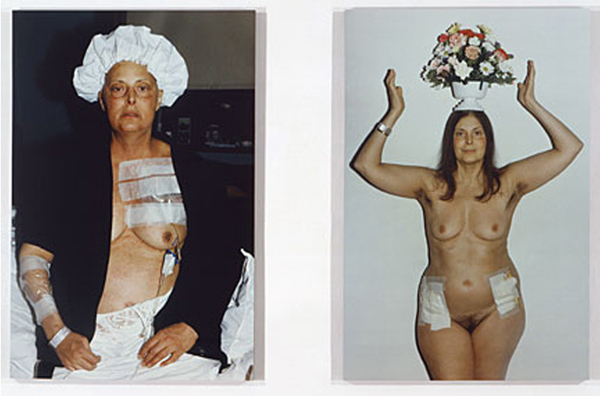
Bandages from Bone Marrow Harvest (right).
Wilke, H. (1992) Intra-Venus Series No. 1, [Chromogenic supergloss print 2 panels]. Ronald Feldman Gallery, New York.
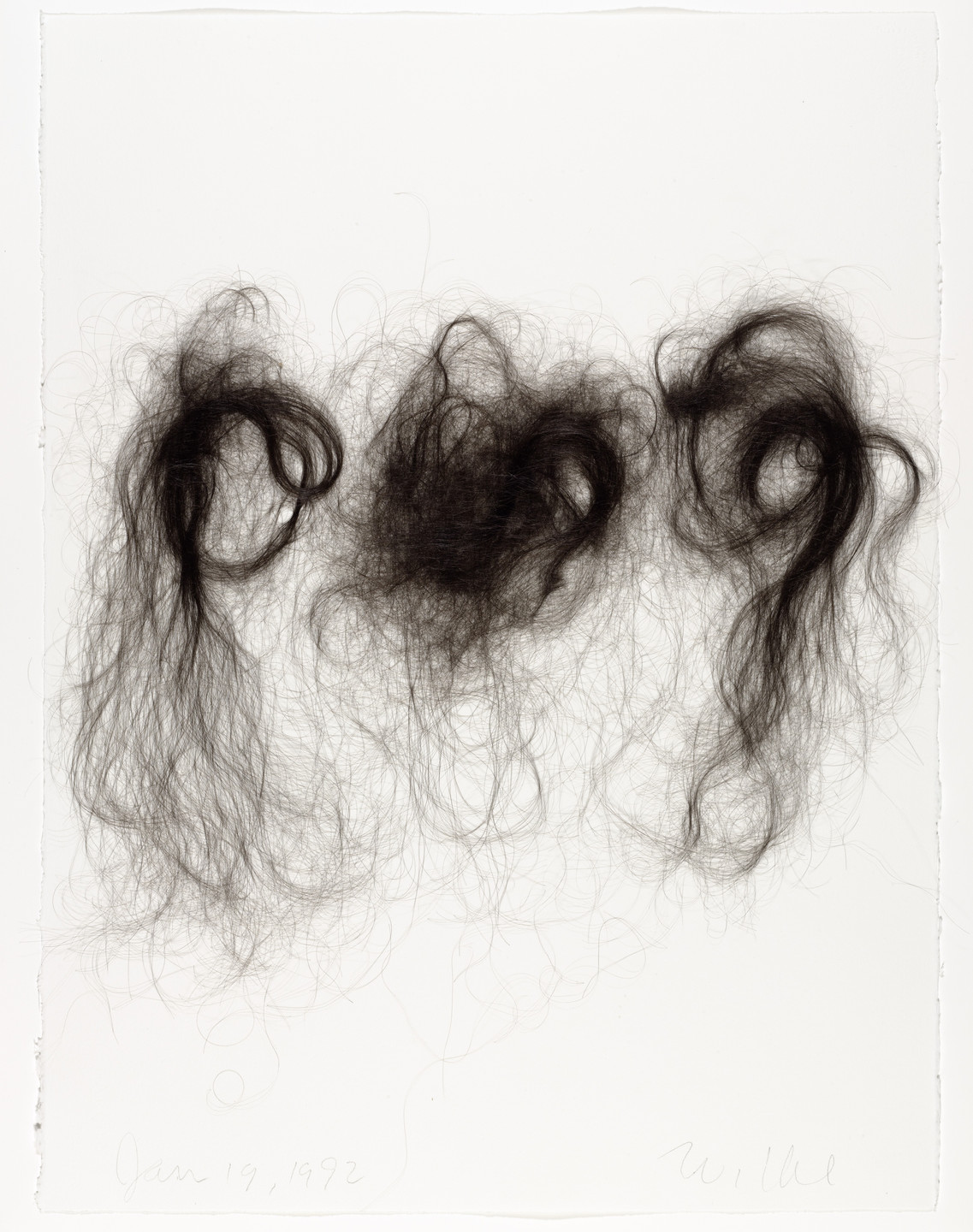
Wilke, H. (1992) Brushstrokes No. 6, [Artist's hair on paper]. Ronald Feldman Gallery, New York.
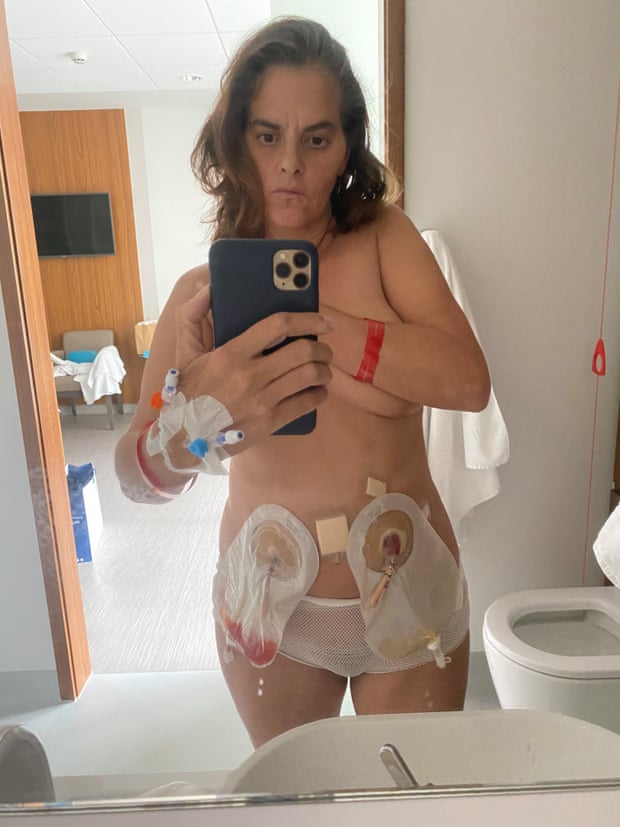
Emin, T (2020) We All Bleed, [Photography].
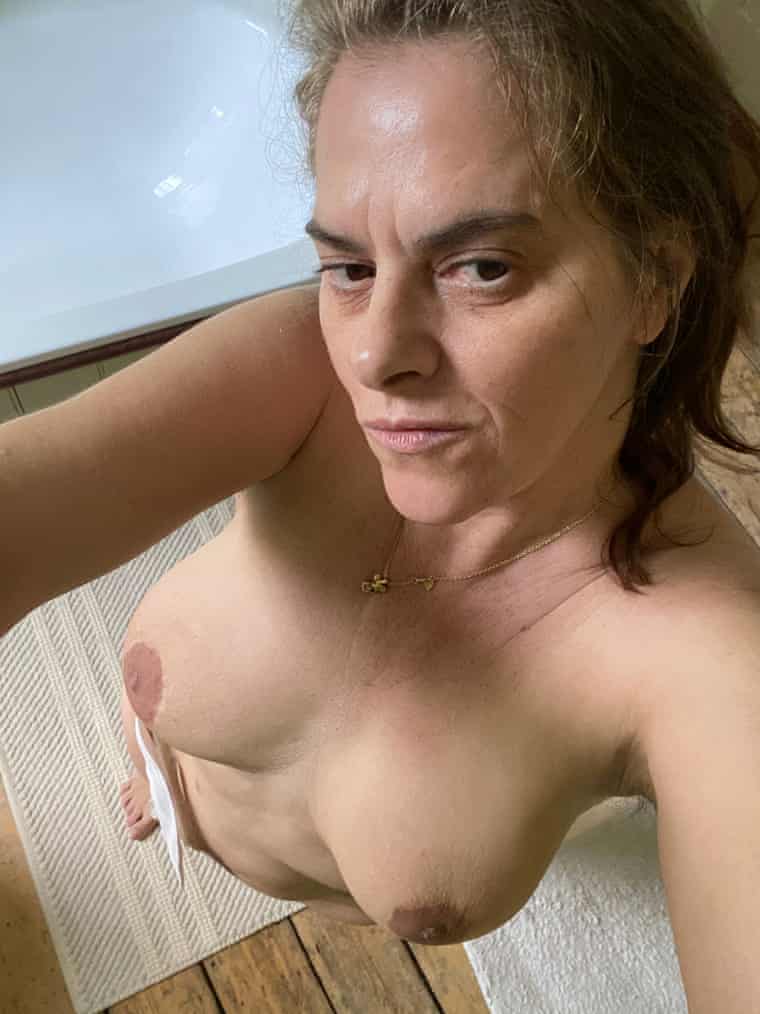
Emin, T (2020) Self-portrait with Urostomy Bag, [Photography].
After receiving her cancer diagnosis, Tracey Emin recorded her treatment and disability through a series of photographs as a way to document her experiences. These photographs, like Wilke, show viewers the various aspects of Emin’s personal battle with cancer. ‘This public ability to speak so universally about her illness… is to help herself and others deal with challenges and stigma.’ (Jones, 2021). ). Emin also discusses elements of disability that are not commonly discussed such as fatigue which can be seen in Exhausting… Self-portrait in bed, this image shows Tracey Emin in her bed with noticeable dark under eyes. Throughout her work Emin has always presented herself in her work in a raw and unfiltered manner, her illness has been no exception ‘Emin is keen to raise awareness, and knows she has a unique opportunity.’ (Durrant, 2021), as she believes that there is a great deal of unspoken understanding for persons with disabilities.
The methodology of this research is practice-led with myself as the participant model, there is use of primary sources from my medical experiences and my personal medical file. There is also an exploration of secondary research through the study and analyse of the works of Kahlo, Wilke and Emin.
My work has, and continues to, enable me to process and express my trauma, diagnosis, pain, and disability. Art has facilitated a space for me to raise awareness and tell my story. My work creates opportunities for the viewer to ask questions, to relate to a time of isolation or pain in their life, and to speak about illness and disability.
Viewing Life through Jaundice Eyes shows a living room in yellow tones, this was in response to being confined to this one room during the height of my illness when I was out of hospital. The yellow tones are a representation of the jaundice I experienced whilst in liver failure. Yellow is also a representative for loneliness and isolation, which is another important key theme in this painting as this theme can relate to everyone globally during the COVID-19 pandemic.
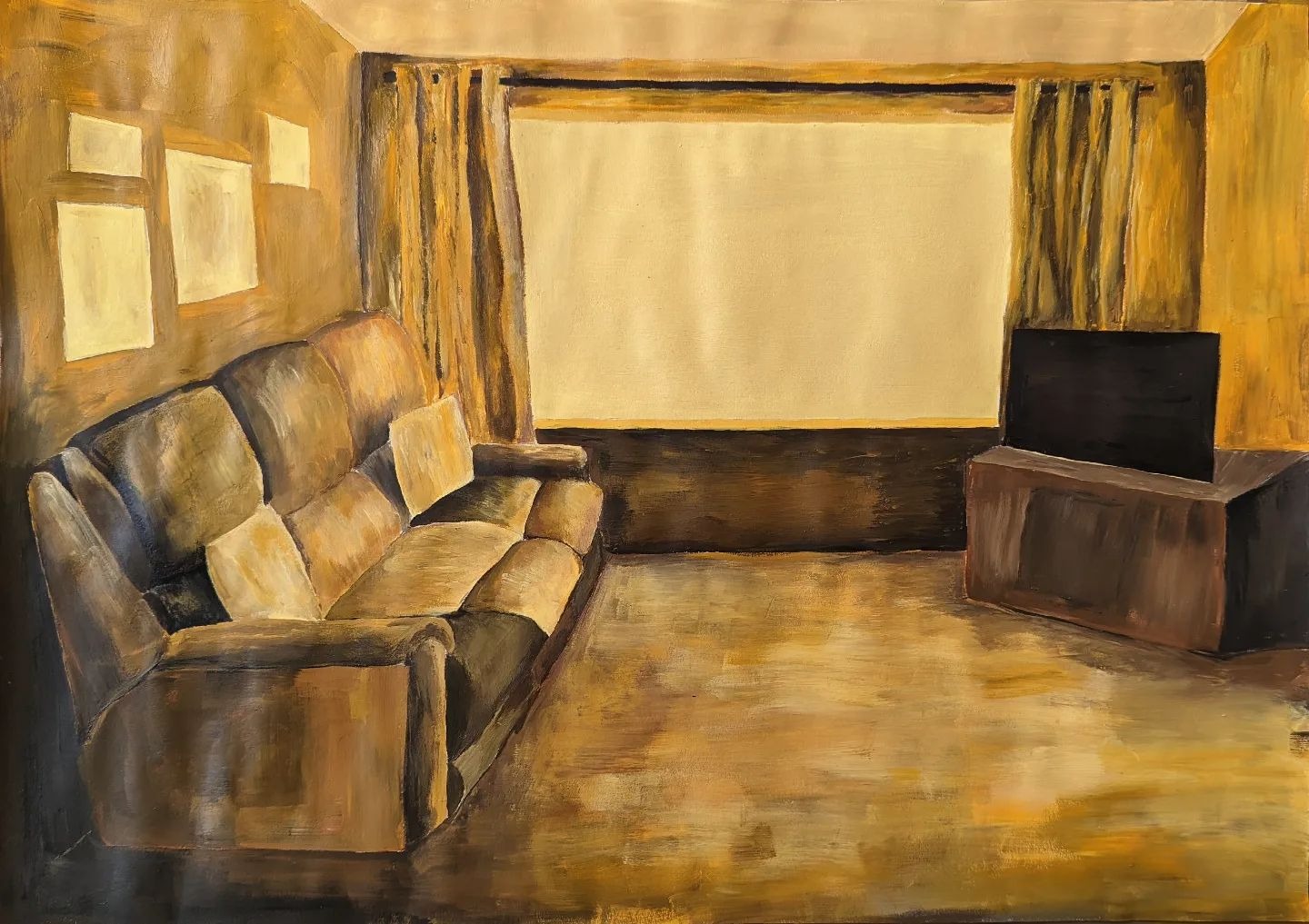
Viewing Life through Jaundice Eyes, 2022.
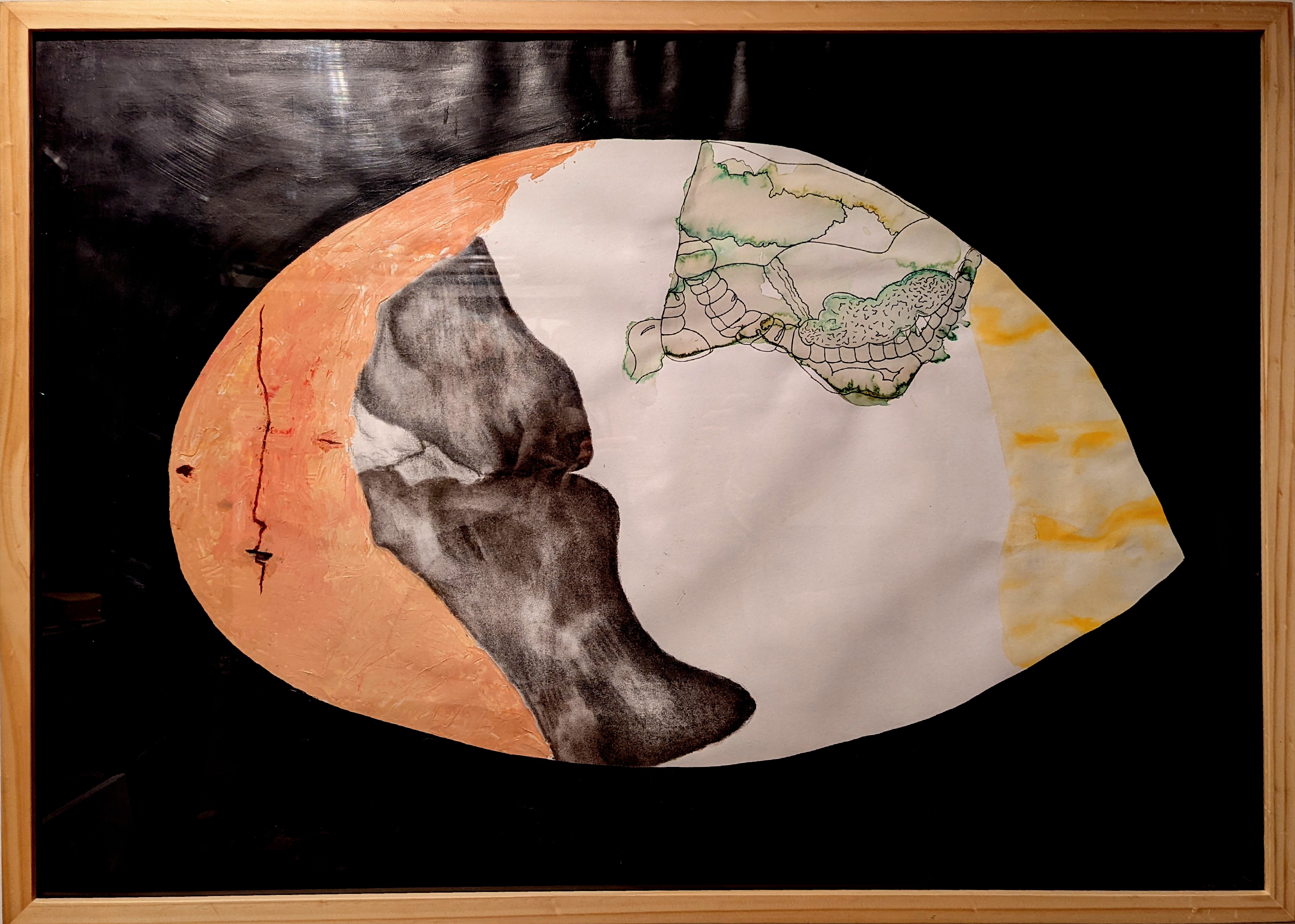
Life Without a Stomach, 2021.
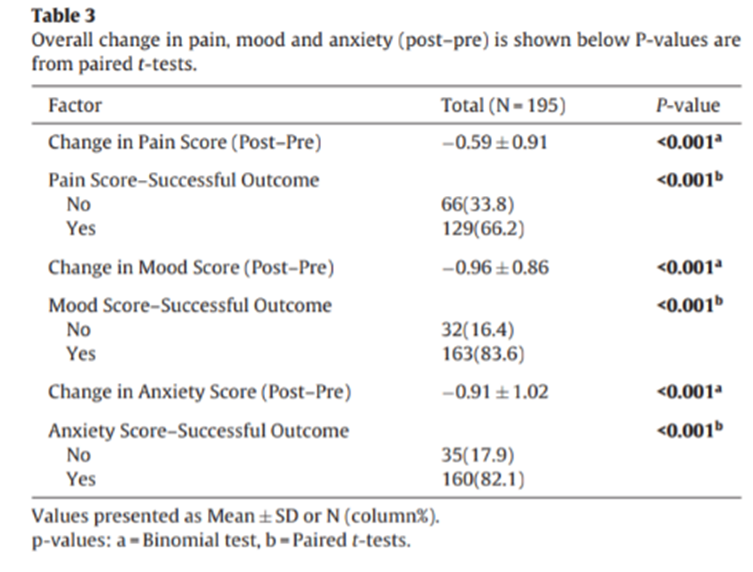
(Shella, 2013).
During my research I have found that there are areas of alternative medication, such as art therapy, which has shown a positive outcome for those who suffer from chronic illnesses. A case study performed by Tamara A. Shella indicates that out of the 195 participants 129 found that their pain levels had improved. The overall results showed that the participants experienced reduced pain and improved mood during art therapy.
This research has led to my hypothesis that reduced pain and elevated mood may be helped by art therapy or the creation of art as it may allow for the ability of processing trauma to the body through illness and pain. When Hannah Wilke battled cancer, she ‘…seems to have wanted to sever the intricate, but now surely agonisingly painful, bonds between her gaze, her body… using photography to objectify her body for herself, to make the signs of cancer and its treatments legible: to make sense of death.’ (Wilke, 1995). Art may grant us to break down our ailments, to support us in understand them and allow us to express emotions and experiences that words cannot.
Acknowledgments:
I would like to express my deepests thanks to the tutors at Blackpool School of Arts for their constant support; Ann Carragher, Nick Kowalski, and Tracey Eastham, to the brilliant and life-saving NHS, without whom I would not be here today and finally to the brave artists mentioned in this research who are such great inspiration.
Reference List:
Archive.ph. (2013) archive.ph. Available at: https://archive.ph/20130120044651/http://www.dacymru.com/dwl/InfoWhat.html (Accessed: 26 February 2022).
Durrant, N. (2021) Tracey Emin on life after cancer and living with a disability. Available at: https://www.standard.co.uk/culture/exhibitions/tracey-emin-exhibition-art-invisible-disability-urostomy-bag-cancer-b933178.html (Accessed: 9 January 2022).
Cheney, E. (1994) 'Hannah Wilke: Intra-Venus' Art Papers, 1 July, pp.60-61.
Jacob, J. (2021) Frida Kahlo: Her Chronic Pain Chronicled in Four Paintings. Available at: https://www.thecollector.com/frida-kahlo-her-chronic-pain-chronicled-in-four-paintings/ (Accessed: 05 January 2022).
Jones, J. (2021) Tracey Emin on her cancer self-portraits: ‘This is mine. I own it’. Available at: https://www.theguardian.com/artanddesign/2021/may/13/tracey-emin-on-beating-cancer-you-can-curl-up-and-die-or-you-can-get-on-with-it (Accessed: 18 February 2022).
Shella, T. (2018) Art Therapy Improves Mood and Reduces Pain and Anxiety When Offered at Beside During Acute Hospital Treatment, The Arts in Psychotherapy, (57), pp.59-62.
Shillinger, S. (2021) Life is Pain: An Exploration of Suffering in Art - Google Arts & Culture. Available at: https://artsandculture.google.com/usergallery/life-is-pain-an-exploration-of-suffering-in-art/GAKyDk9OtIm9KQ (Accessed: 09 February 2022).
Wilke, H. (1995) Intra-Venus. New York: Ronald Feldman Fine Arts.
Wise, L. (2022) ‘I am here. I’m alive.’ Tracey Emin on health, wealth and finding happiness. Available at: https://www.ft.com/content/ffd55216-7751-43d3-9ad8-f495 cb0d7c7 (Accessed: 5 January 2022).
Slide 1 image (max 2mb)
Slide 1 video (YouTube/Vimeo embed code)
Image 1 Caption
Slide 2 image (max 2mb)
Slide 2 video (YouTube/Vimeo embed code)
Image 2 Caption
Slide 3 image (max 2mb)
Slide 3 video (YouTube/Vimeo embed code)
Image 3 Caption
Slide 4 image (max 2mb)
Slide 4 video (YouTube/Vimeo embed code)
Image 4 Caption
Slide 5 image (max 2mb)
Slide 5 video (YouTube/Vimeo embed code)
Image 5 Caption
Slide 6 image (max 2mb)
Slide 6 video (YouTube/Vimeo embed code)
Image 6 Caption
Slide 7 image (max 2mb)
Slide 7 video (YouTube/Vimeo embed code)
Image 7 Caption
Slide 8 image (max 2mb)
Slide 8 video (YouTube/Vimeo embed code)
Image 8 Caption
Slide 9 image (max 2mb)
Slide 9 video (YouTube/Vimeo embed code)
Image 9 Caption
Slide 10 image (max 2mb)
Slide 20 video (YouTube/Vimeo embed code)
Image 10 Caption
Caption font
Text
Image (max size: 2mb)
Or drag a symbol into the upload area
















Image description/alt-tag
Image caption
Image link
Rollover Image (max size: 2mb)
Or drag a symbol into the upload area
















Border colour
Rotate
Skew (x-axis)
Skew (y-axis)
Image (max size: 2mb)
Or drag a symbol into the upload area
















Image description/alt-tag
Image caption
Image link
Rollover Image (max size: 2mb)
Or drag a symbol into the upload area
















Border colour
Rotate
Skew (x-axis)
Skew (y-axis)
Image (max size: 2mb)
Or drag a symbol into the upload area
















Image description/alt-tag
Image caption
Image link
Rollover Image (max size: 2mb)
Or drag a symbol into the upload area
















Border colour
Rotate
Skew (x-axis)
Skew (y-axis)
Image (max size: 2mb)
Or drag a symbol into the upload area
















Image description/alt-tag
Image caption
Image link
Rollover Image (max size: 2mb)
Or drag a symbol into the upload area
















Border colour
Rotate
Skew (x-axis)
Skew (y-axis)
Image (max size: 2mb)
Or drag a symbol into the upload area
















Image description/alt-tag
Image caption
Image link
Rollover Image (max size: 2mb)
Or drag a symbol into the upload area
















Border colour
Rotate
Skew (x-axis)
Skew (y-axis)
Image (max size: 2mb)
Or drag a symbol into the upload area
















Image description/alt-tag
Image caption
Image link
Rollover Image (max size: 2mb)
Or drag a symbol into the upload area
















Border colour
Rotate
Skew (x-axis)
Skew (y-axis)
Image (max size: 2mb)
Or drag a symbol into the upload area
















Image description/alt-tag
Image caption
Image link
Rollover Image (max size: 2mb)
Or drag a symbol into the upload area
















Border colour
Rotate
Skew (x-axis)
Skew (y-axis)
Image (max size: 2mb)
Or drag a symbol into the upload area
















Image description/alt-tag
Image caption
Image link
Rollover Image (max size: 2mb)
Or drag a symbol into the upload area
















Border colour
Rotate
Skew (x-axis)
Skew (y-axis)
Image (max size: 2mb)
Or drag a symbol into the upload area
















Image description/alt-tag
Image caption
Image link
Rollover Image (max size: 2mb)
Or drag a symbol into the upload area
















Border colour
Rotate
Skew (x-axis)
Skew (y-axis)